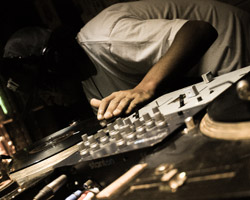
Photo Credit: foradoeixo
This article assumes you already know how to beatmatch. For more information on beatmatching, check out our definition of beatmatching or our guide on learning how to beatmatch.
-
Learn with Easy to Mix Tracks
Start learning to mix with some simple house or trance tracks with a very clear 4 on the floor beat. Try and find two songs that both start with the beat and not a long intro.
-
Tap Your Cue Button Before The Track Drops
If you are on a digital setup then you have the ability to use your cue button to tap the first hit of your cued song. Do this with the last few beats of the phrase of your main song and then let it ride after the phrase starts. By starting this way you will allow yourself to get in the rhythm of the main track and if there is some sort of change as the phrase starts, it will prevent you from missing the drop.
-
Start from the Second Hit
Another way to keep from missing the start of a phrase is to set your cued song to drop on the second beat of the phrase. This way you can hear the first beat of the phrase of the master and then quickly play your cued track as the second beat hits. This technique is great to use for faster breakbeat genres like Drum & Bass.
-
Listen to the High Pitched Elements
It is much easier to match higher pitched elements than trying to rely on the bassline. You can even turn down the low EQ on your cued track to hear the highs better.
-
Let it Ride
Once you have played your cued track, its time to let it ride. Too much pitch adjustment will only make things take longer when you are trying to beatmatch. Let a track ride for a bit without listening through the headphones. Come back and hear how the tracks have drifted apart over time and make your adjustment.
-
Practice Your Timing
Getting the feel for how long it takes for a track to go out of sync is the key to beatmatching quickly. For instance if you hear a track go out of sync within 4 beats then you know the pitch needs a large adjustment. If it takes 64 beats for you to notice a track is drifting out of sync then it will only take a small one. Developing a sense for this will take practice, but in the end it will make you a much better DJ.
-
Match the Claps
It is a DJ trade secret that if you can match the claps of two tracks then you know that they are on sync. This works because claps are usually short and snappy elements of a track. Matching these elements takes accurate beatmatching that you can rely on to sound good.


Leave a Reply
You must be logged in to post a comment.